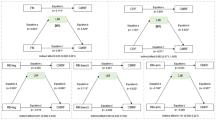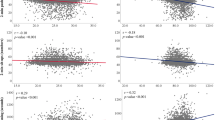Abstract
Objective:
To test two hypotheses: (1) cardiorespiratory (CRF) and neuromuscular (NMF) fitness is associated with body mass index (BMI) and waist circumference (WC), independent of each other and of leisure-time physical activity; (2) individuals with high CRF and NMF have lower WC for a given BMI, compared with those with low CRF and NMF.
Design:
Cross-sectional study.
Setting:
Men participating in refresher training organized by the Finnish Defence Forces.
Participants:
A total of 951 men (mean age 29.1, s.d. 4.2 years; BMI 25.3 kg/m2, s.d. 3.8; WC 91, s.d. 11 cm).
Main outcome measures:
Body mass index, WC, maximal oxygen uptake (VO2max), height of vertical jump, number of push-ups and sit-ups during a 1-min test, static back extension endurance, isometric grip strength, self-reported leisure-time vigorous physical activity. Multiple linear regressions were used to explain the variation in fitness.
Results:
Waist circumference had significant (P<0.001) negative association with all test results (standardized beta coefficients from −0.23 to −0.77), except for grip strength. Body mass index had significant negative association with VO2max (−0.12; P<0.05), but positive association (P<0.01) with grip strength (0.28), vertical jump (0.21) and push-ups (0.55). For a given BMI, the estimated WC was highest among those with the poorest results for VO2max, vertical jump, sit-ups and push-ups.
Conclusions:
Despite stronger isometric grip strength, the functional muscle fitness of the upper body, trunk and lower extremities is impaired in individuals with abdominal obesity. Although the known loss of CRF is a serious consequence of obesity, the deterioration of NMF deserves increased attention.
This is a preview of subscription content, access via your institution
Access options
Subscribe to this journal
Receive 12 print issues and online access
$259.00 per year
only $21.58 per issue
Buy this article
- Purchase on SpringerLink
- Instant access to full article PDF
Prices may be subject to local taxes which are calculated during checkout


Similar content being viewed by others
References
Bouchard C, Shephard RJ . Physical activity, fitness, and health: the model and key concepts. In: Bouchard C, Shephard RJ, Stephens T (eds). Physical Activity, Fitness and Health. Human Kinetics: Champaign, IL, 1994, pp 77–88.
Evenson KR, Stevens J, Cai J, Thomas R, Thomas O . The effect of cardiorespiratory fitness and obesity on cancer mortality in women and men. Med Sci Sports Exerc 2003; 35: 270–277.
Bertoli A, Di Daniele N, Ceccobelli M, Ficara A, Girasoli C, De Lorenzo A . Lipid profile, BMI, body fat distribution, and aerobic fitness in men with metabolic syndrome. Acta Diabetol 2003; 40 (Suppl 1): S130–S133.
Wei M, Kampert JB, Barlow CE, Nichaman MZ, Gibbons LW, Paffenbarger Jr RS et al. Relationship between low cardiorespiratory fitness and mortality in normal-weight, overweight, and obese men. JAMA 1999; 282: 1547–1553.
Williams PT . Health effects resulting from exercise versus those from body fat loss. Med Sci Sports Exerc 2001; 33: S611–S622.
Guralnic JM, Ferrucci L, Simonsick EM, Salive ME, Wallace RB . Lower-extremity function in persons over the age of 70 years as a predictor of subsequent disability. N Engl J Med 1995; 332: 556–561.
Häkkinen K, Kallinen M, Izquierdo M, Jokelainen K, Lassila H, Mälkiä E et al. Changes in agonist–antagonist EMG, muscle CSA, and force during strength training in middle-aged and older people. J Appl Physiol 1998; 84: 1341–1349.
Warburton DER, Gledhill N, Quinney A . The effects of changes in musculoskeletal fitness on health. Can J Appl Physiol 2001; 26: 161–216.
Malmberg J, Miilunpalo S, Vuori I, Pasanen M, Oja P, Haapanen-Niemi N . A Health-related fitness and functional performance test battery for middle-aged and older adults: feasibility and health-related content validity. Arch Phys Med Rehabil 2002; 83: 666–677.
Suni JH, Oja P, Miilunpalo SI, Pasanen ME, Vuori IM, Bös K . Health-related fitness test battery for adults: associations with perceived health, mobility, and back function and symptoms. Arch Phys Med Rehabil 1998; 79: 559–569.
Pohjonen T . Age-related physical fitness and the predictive values of fitness tests for work ability in home care work. J Occup Environ Med 2001; 43: 723–730.
WHO. Obesity: Preventing and managing the global epidemic. Report on a WHO Consultation. Technical Report Series 894. WHO Press: Geneva, 2000.
Kelley DE, Thaete FL, Troost F, Huwe T, Goodpaster BH . Subdivisions of subcutaneous abdominal adipose tissue and insulin resistance. Am J Physiol Endocrinol Metab 2000; 278: E941–E948.
Ross R, Aru J, Freeman J, Hudson R, Janssen I . Abdominal adiposity and insulin resistance in obese men. Am J Physiol Endocrinol Metab 2002; 282: E657–E663.
Janssen I, Katzmarzyk PT, Ross R . Waist circumference and not body mass index explains obesity-related health risk. Am J Clin Nutr 2004; 79: 379–384.
Miyatake N, Takanami S, Kawasaki Y, Fujii M . Relatioship between visceral fat accumulation and physical fitness in Japanese women. Diab Res Clin Pract 2004; 64: 173–179.
Ross R, Katzmarzyk PT . Cardiorespiratory fitness is associated with diminished total and abdominal obesity independent of body mass index. Int J Obes Relat Metab Disord 2003; 27: 204–210.
Janssen I, Katzmarzyk PT, Ross R, Leon AS, Skinner JS, Rao DC et al. Fitness alters the association of BMI and waist circumference with total and abdominal fat. Obes Res 2004; 12: 525–537.
Wong SL, Katzmarzyk PT, Nichaman MZ, Church TS, Blair SN, Ross R . Cardiorespiratory fitness in associated with lower abdominal fat independent of body mass index. Med Sci Sports Exerc 2004; 36: 286–291.
Hulens M, Vansant G, Lysens R, Claessens AL, Muls E, Brumagne S . Study of differences in peripheral muscle strength of lean versus obese women: an allometric approach. Int J Obes Relat Metab Disord 2001; 25: 676–681.
Rolland Y, Lauwers-Cances V, Pahor M, Fillaux J, Grandjean H, Vellas B . Muscle strength in obese elderly women: effect of recreational physical activity in a cross-sectional study. Am J Clin Nutr 2004; 79: 552–557.
Suni JH, Miilunpalo SI, Asikainen T-M, Laukkanen RT, Oja P, Pasanen ME et al. Safety and feasibility of a health-related fitness test battery for adults. Phys Ther 1998; 78: 134–148.
Su C-Y, Lin J-H, Chien T-H, Cheng KF, Sung YT . Grip strength in different positions of elbow and shoulder. Arch Phys Med Rehabil 1994; 75: 812–815.
Bosco C, Luhtanen P, Komi PV . A simple method for measurement of mechanical power in jumping. Eur J Appl Physiol Occup Physiol 1983; 50: 273–282.
Åstrand PO, Rhyming I . A Nomogram for calculation of aerobic capacity (physical fitness) from pulse rate during submaximal work. J Appl Physiol 1954; 7: 218–221.
Keskinen K, Keskinen O, Takalo T, Häkkinen K . Comparison between straight measurement and two concurrent protocols to predict maximal oxygen uptake. Med Sci Sports Exerc 2002; 34: S271.
Viljanen T, Viitasalo JT, Kujala UM . Strength characteristics of a healthy urban adult population. Eur J Appl Physiol 1991; 63: 43–47.
Meir R, Newton R, Curtis E, Fardell M, Butler B . Physical fitness qualities of professional rugby league football players: determination of positional differences. J Strength Cond Res 2001; 15: 450–458.
Roberts MA, O'Dea J, Boyce A, Mannix ET . Fitness levels of firefighter recruits before and after a supervised exercise training program. J Strength Cond Res 2002; 16: 271–277.
Malina RM, Beunen GP, Claessens AL, Lefevre J, Vanden Eynde B, Renson R et al. Fatness and physical fitness of girls 7 to 17 years. Obes Res 1995; 3: 221–231.
Hulens M, Vansant G, Claessens AL, Lysens R, Muls E . Predictors of 6-min walk test in lean, obese and morbidly obese women. Scand J Med Sci Sports 2003; 13: 98–105.
Jebb SA, More MS . Contribution of a sedentary lifestyle and inactivity to the etiology of overweight and obesity: current evidence and research issues. Med Sci Sports Exerc 1999; 31 (Suppl 11): S534–S541.
Lafortuna CL, Resnik M, Galvani C, Sartorio A . Effects if non-specific vs individualized exercised training protocols on aerobic, anaerobic and strength performance in severely obese subjects during a short-term body mass reduction program. J Endocrinol Invest 2003; 16: 197–205.
Visser M, Langlois J, Guralnik JM, Cauley JA, Kronmal RA, Robbins J et al. High body fatness, but not low fat-free mass, predicts disability in oler men and women. The cardiovascular health study. Am J Clin Nutr 1998; 68: 584–590.
Wannamethee SG, Shaper AG, Whincup PH, Walker M . Overweight and obesity and the burden of disease and disability in elderly men. Int J Obes Relat Metab Disord 2004; 28: 1374–1382.
Janssen I, Heymsfield SB, Allison DB, Kotler DP, Ross R . Body mass index and waist circumference independently contribute to the prediction of nonabdominal, abdominal subcutaneous, and visceral fat. Am J Clin Nutr 2002; 75: 683–688.
Ross R, Dagnone D, Jones PJ, Smith H, Paddags A, Hudson R et al. Reduction in obesity and related comorbid conditions after diet-induced weight loss or exercise-induced weight loss in men. A randomized, controlled trial. Ann Intern Med 2000; 133: 92–103.
Aromaa A, Koskinen S (eds). Health and Functional Capacity in Finland. Baseline Results of the Health 2000 Health Examination Survey. Publications of the National Public Health Institute B12/2004: Helsinki, 2004.
Shvartz E, Reibold RC . Aerobic fitness norms for males and females aged 6 to 75 years: a review. Aviat Space Environ Med 1990; 61: 3–11.
MacAuley D, Mc Crum EE, Stott G, Evans AE, Gamble RP, Mc Roberts B et al. Levels of physical activity, physical fitness and their relationship in the Northern Ireland Health and Activity Survey. Int J Sports Med 1998; 19: 503–511.
Acknowledgements
This study was supported by a grant from the Scientific Committee for National Defence. We are grateful to Matti Pasanen, MSc, The UKK Institute, for valuable statistical advice and for critical comments on our paper, and to Kari Keskinen, PhD, for sharing the results from Fitware validation study.
Author information
Authors and Affiliations
Corresponding author
Rights and permissions
About this article
Cite this article
Fogelholm, M., Malmberg, J., Suni, J. et al. Waist circumference and BMI are independently associated with the variation of cardio-respiratory and neuromuscular fitness in young adult men. Int J Obes 30, 962–969 (2006). https://doi.org/10.1038/sj.ijo.0803243
Received:
Revised:
Accepted:
Published:
Issue Date:
DOI: https://doi.org/10.1038/sj.ijo.0803243
Keywords
This article is cited by
-
Body surface scan anthropometrics are related to cardiorespiratory fitness in the general population
Scientific Reports (2022)
-
Individual and interpersonal correlates of cardiorespiratory fitness in adults – Findings from the German Health Interview and Examination Survey
Scientific Reports (2020)
-
Double burden of malnutrition in persons with obesity
Reviews in Endocrine and Metabolic Disorders (2020)
-
Correlates and Determinants of Cardiorespiratory Fitness in Adults: a Systematic Review
Sports Medicine - Open (2019)
-
The impact of cardiorespiratory fitness on classical cardiovascular disease risk factors in rheumatoid arthritis: a cross-sectional and longitudinal study
Rheumatology International (2019)



